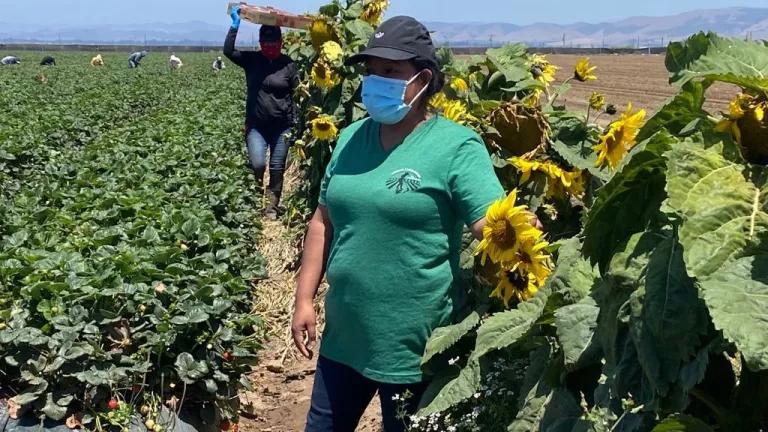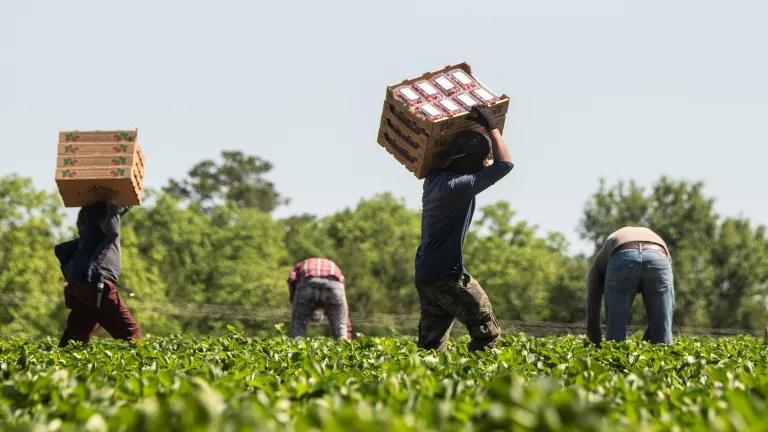Food Work & COVID: Farmworker Solutions for an Unjust System
Farmworkers have long dealt with unsafe working and living conditions, low wages and lack of job security, disparate levels of food insecurity, and vulnerable immigration statuses—a dangerous combination of systemic injustices underpinned by racism in the food system. But as they have done for decades, farmworkers are designing their own solutions.

Lideres Campesinas conducts farmworker outreach during a strawberry harvest in California.
In the early days of the COVID-19 pandemic, our food system, typically invisible to and taken for granted by many consumers, took center stage. While some in the United States transitioned to remote work, this was never an option for food system workers, who represent more than one in seven of all workers in the country.
Millions of food system workers, including nearly six million restaurant workers, faced immediate unemployment. Millions more who worked on farms, in processing plants, and at grocery stores were deemed essential and had to show up to work every day, facing greater exposure to COVID-19 and higher rates of infection and death, especially among workers of color, as the pandemic tore across the country. The reported number of food system workers infected by COVID-19 varies. Purdue University’s College of Agriculture estimates more than 630,000 agricultural workers have tested positive nationwide as of August 2021, still likely an undercount because the number excludes contracted and temporary labor.
While the pandemic highlighted and exacerbated the brittle and deeply inequitable nature of our food system, these are longstanding and systemic problems. Food workers, particularly those who work on farms and in food production, have long dealt with unsafe working and living conditions, low wages and lack of job security, disparate levels of food insecurity, and vulnerable immigration statuses—a dangerous combination of systemic injustices underpinned by racism in the food system. But as they have done for decades, farmworkers are designing their own solutions.
COVID-19 Exacerbated Longstanding Injustices for Farmworkers
Today, more than 21 million people in the United States work to grow and harvest, process and manufacture, and cook, serve, transport, and sell the food that we all depend on. And despite impactful activism and significant strides delivered by frontline organizers of color, food work today remains plagued by serious health and safety risks, low wages and poor job security, frequent food insecurity, and other systemic burdens.
Unsafe Working and Living Conditions
As in-person work continued for farmworkers throughout the pandemic, they faced dangerous and troubling conditions. Firsthand accounts from advocacy groups like Lideres Campesinas, a network of women farmworker leaders based in California, reported that many farms did not adhere to social distancing, with groups of up to 60 people working side-by-side throughout the pandemic.
Additionally, especially in the early months of the pandemic, personal protective equipment (PPE) was scarce for many farmworkers. In some places, advocacy organizations like the Farmworker Association of Florida, a grassroots, community-based farmworker membership organization, covered gaps left by employers and the state by providing free PPE to farmworkers. According to Jeannie Economos, Pesticide Safety and Environmental Health Project Coordinator for the organization, many farmworkers recounted that prior to the intervention from the Farmworker Association, they were being given “one mask for the whole week, and it’s hot in Florida, so that mask gets dripping wet, dirty, and ineffective in the first hour they’re outside.” COVID-19 outbreaks emerged on farms across the country, impacting communities in at least 18 states including California, Florida, Illinois, Missouri, New York, North Carolina, Ohio, Tennessee, Texas, and Washington.
The pandemic also exacerbated persistent housing inequities experienced by farmworkers and their families. With people out of work, safe housing became even more difficult to afford, and overcrowding made public health recommendations for social distancing impossible to follow.
Compounding the risk of exposure and infection as frontline pandemic workers, farmworkers are less likely to visit a doctor even when they become sick. Many farmworkers lack meaningful access to healthcare owing to prohibitive costs, few clinics in rural areas, the inability to get sick leave and concern about missing paid work time, and for undocumented workers, a fear of how their immigration status will affect eligibility.
Beyond these heightened safety concerns created by the COVID-19 pandemic, there are environmental health risks that regularly create unsafe conditions for farmworkers and their families. First, according to Farmworker Justice and the Migrant Clinicians Network, agricultural workers are at significant risk for heat stress because their work is physically demanding over long hours, in hot and sometimes humid climates. In the short term, heat stress can lead to more severe heat illness including heat exhaustion, heat stroke, and even death, while chronic heat stress is associated with kidney disease. Farmworkers die of heat-related causes at roughly 20 times the rate of workers in all other civilian occupations.
Second, pesticide exposure causes farmworkers to suffer more chemical-related injuries and illnesses than any other workforce nationwide. According to a Farmworker Justice report, “there is an estimated 5.1 billion pounds of pesticides applied to crops each year, and thousands of farmworkers experience the effects of acute pesticide poisoning, including headaches, nausea, shortness of breath, or seizures. Pesticide exposure leads to chronic health problems, such as cancer, infertility (and other reproductive problems), neurological disorders, and respiratory conditions.”
Farmworkers are routinely exposed to pesticides through a variety of pathways. For example, workers who perform tasks in pesticide-treated areas risk exposure from direct spray, aerial drift, or contact with pesticide residues on the crop or soil. Workers who mix, load, or apply pesticides can be exposed to pesticides from spills, splashes, and defective, missing, or inadequate protective equipment.
In a 2012 study commissioned by the Farmworker Association of Florida, researcher Laura Bermudez interviewed farmworkers in ornamental plant nurseries in Central Florida. Several reported that in their ten or more years working at a nursery, employers never provided educational materials about the dangers of pesticide exposure. As one study participant, Ingrid, described, “Ese spray mareaba y te adormecía. No daban nada para protegerse, ni guantes, ni gafas, ni máscara. [That spray made you dizzy and sleepy. They didn’t give you anything to protect yourself, no gloves, no goggles, no facemask.]” Another worker, Rosa Maria, took matters into her own hands, creating signs in Spanish to warn her coworkers against entering the nursery after spraying occurred.
Pesticide risk is not limited to occupational exposure in the fields or nurseries. Farmworkers may inadvertently bring pesticides home to their families through residue on their clothes or tools. For those living near the land they work, additional exposure pathways include ingestion of contaminated groundwater, outdoor recreation, or eating produce grown near the crops sprayed with pesticides.
Finally, farmworkers also suffer health problems because of inadequate and unsafe housing. According to the U.S. Department of Labor, as of 2016, 16 percent of hired farmworkers live in employer-provided housing and 33 percent live in crowded housing. As Jeannie Economos describes, “it’s typical for them to live in housing that has lead paint, that is adjacent to fields where pesticides can drift into the home, where there are unsanitary conditions including unsafe drinking water, so they are at increased risk for other kinds of health problems.”
Substandard housing can also exacerbate heat illness, as described in a 2019 article where Leydy Rengle of the United Farm Workers Foundation recalled the extreme heat in her family’s trailer home: “My parents would come home after 10-hour shifts, and didn’t have a place to cool down.” In the same publication, University of California Davis public health professor Dr. Marc Schenker points out that this can be dangerous as “nighttime cooling is an important factor in preventing heat stress illness.”
In addition to the overall lack of adequate and affordable housing in these communities, poor housing conditions are often linked to other social vulnerabilities. A 2007 and 2008 survey of migrant camps in North Carolina found that the majority had substandard conditions, and that substandard conditions were more likely in camps where resident workers are undocumented, speak indigenous languages, and are women.
As Jeannie Economos notes, the crux of all of these health and safety issues is that profit is valued over workers. “Growers are more interested in getting their product out, getting the crop picked, getting the crop packed, or getting their fields ready, than they are in their workers’ health, safety, and wellbeing. Farmworkers tell us that some growers treat their pets better than they treat their workers.”

Free facemask distribution organized by the Farmworker Association of Florida in May 2020.
Low Wages and Poor Job Security
While many farmworkers experienced more dangerous working conditions because of COVID-19, others lost their jobs. In spring 2020, the pandemic severely disrupted the food supply chain. With restaurants, hotels, and schools closed, many of the nation’s large farms had far more product than was being purchased. Dairy farms dumped out hundreds of gallons of milk, crops rotted in fields, and as a result, farmworkers found themselves out of work. By the time the food supply chain began to bounce back, it was summer, and June starts the off-season in regions of the U.S. with hotter climates. Typically seasonal farmworkers migrate to other parts of the country for summer work. But by the summer of 2020, as Jeannie Economos describes, “seasonal workers didn't have any more work here in Florida, and they were afraid to travel to other places because of the pandemic.”
As in other industries, with schools and daycares closed, households that typically relied on two incomes suddenly needed someone at home to manage childcare and remote schooling. Due to low wages and exclusion from unemployment benefits, many farmworkers lack a financial safety net, and a loss of employment can mean almost immediate financial hardship. To make matters worse, undocumented farmworkers were excluded from financial support targeting COVID-19 hardships and did not receive a single stimulus check in 2020 (other members of their household who are citizens or permanent residents were also excluded from the first round of stimulus checks).
Even without the uncertainty of the pandemic, wages for agricultural workers are markedly low. According to the U.S. Department of Labor, the average annual income of a farmworker family is below $25,000 and one-third of farmworkers have family income below the federal poverty level. Not only are wages low, but they are often tied directly to productivity through the “piece rate” system, which is dependent on how much of a crop someone harvests. This payment scheme creates disincentive for workers to take breaks for water or shade, and can mean that a farmworker’s hourly rate is less than a state’s minimum wage. Low wages are compounded by a persistent lack of job security. Employers demand efficiency, and lay off or provide lower pay to those perceived to not produce quickly, such as women and elderly people.
Because of both low wages and job insecurity, food system workers commonly experience food insecurity, meaning they are unable to provide enough food for every person in their household to live an active, healthy life. Farmworkers are hit particularly hard by hunger, with studies finding that between 20 and 80 percent of farmworkers experience food insecurity at various times during the seasonal work year. At the same time, only 18 percent of farmworkers nationwide make use of federal Supplemental Nutrition Assistance Program benefits—in part because undocumented workers are ineligible, and in part because others who may be eligible fear that use of public benefit programs could harm their immigration status. And because of farmworkers’ long hours, it can be difficult for many to even access grocery stores and food banks when they are open or have supply.
Vulnerable Immigration Status
The conditions described above are further compounded by the injustices and discrimination associated with farmworkers’ immigration status. It is estimated that three-quarters of U.S. agricultural workers are immigrants, and the majority of those are undocumented.
Jeannie Economos recounts one Florida worker’s description of her workplace, characterized by “two crews: the documented and the undocumented crew, working the same field. The documented crew got lunch breaks, rest breaks, and water, while the undocumented crew was treated completely differently.”
Further, as described by a Human Rights Watch report, “The lack of any immediate prospect for gaining legal status affects the ability of unauthorized farmworkers to report sexual violence, sexual harassment, and other workplace abuses in myriad ways. Although U.S. law entitles unauthorized workers to workplace protections...the U.S. government’s interest in protecting unauthorized workers from abuse conflicts with its interest in deporting them.” This tension makes it risky for undocumented farmworkers, or those with undocumented family members, to report abuses to police or employers. Undocumented workers also have a harder time finding legal representation because federally funded legal services organizations can only represent U.S. citizens, with limited exceptions. In many states, there aren’t other options for affordable support for low-income individuals.
The dynamic around immigration is changing for farmworkers. “For decades, the agricultural industry would simply look away from undocumented workers’ status because they needed them,” Jeannie Economos shares. “But in recent years, amid a wave of anti-immigrant sentiment in federal and state governments, growers have been afraid to hire undocumented workers for fear of being targeted. This pushes undocumented workers into an underground economy in which they are even more deeply exploited by sub-sub contractors.”
Farmworkers Have Solutions for an Unjust Food System
Building on decades of organizing and community-driven advocacy, farmworkers and organizations serving them called for and were successful in securing health and safety protections during the pandemic. These advocates are charting a path for long-term, systemic solutions.
Critical Public Health Services During the Pandemic
The Farmworker Association of Florida has worked to build power among farmworker and rural low-income communities for over 35 years. Staffed by mostly former farmworkers, the organization has long been a trusted resource for farmworkers. During the pandemic, in addition to covering the gap left by employers who failed to provide PPE, the Farmworker Association distributed other necessities like hand sanitizer and food. Along with the Rural Women’s Health Project, the organization produced videos and educational materials to disseminate information and dispel myths about the virus. The Farmworker Association also organized alongside farmworkers to improve COVID-19 vaccine access to undocumented Floridians, including by pushing the state to eliminate a proof of residency vaccine eligibility requirement, which many undocumented people do not readily have.
In California, Lideres Campesinas brought farmworker voices and needs directly to Governor Gavin Newsom in an April 2020 letter outlining eight concrete recommendations for actions to improve access to food, healthcare, shelter, and financial support. In the organization’s second letter to Newsom nearly a year later laying out recommendations for vaccine distribution among farmworkers, Lideres Campesinas chronicled much of its incredible work during the pandemic:
“We have partnered with so many organizations statewide and in various efforts including but not limited to coalitions with growers, health professionals, and advocates, campaigns for safety nets, advocacy for farmworker bills, and research studies such as the [COVID-19 Farmworker Study] which confirmed with data, what we see on the ground in our daily work. We have conducted focus groups, trained more and more community health/outreach workers and have participated extensively in worldwide media coverage in order to address and respond to both the long-standing issues brought to the fore by the pandemic and those that have been affected by it. Our members and staff along with other organizations and farmworkers themselves have been on the frontlines organizing food distribution, testing, mobile health clinics, education, linkage to resources, and distribution of personal protective equipment in rural communities, as well as to the fields and packing houses.”

Lideres Campesinas distributes free PPE and COVID-19 resources to California farmworkers. Courtesy of Lideres Campesinas
In addition to pandemic-specific strategies, farmworkers and the organizations that serve them are pressing for policy reforms across issues of health and safety, labor standards and wage protection, and immigration reform to better protect farmworkers from longstanding threats to their wellbeing.
Worker Health and Safety
The Protect America’s Children from Toxic Pesticides Act of 2020 would reform the Federal Insecticide, Fungicide, and Rodenticide Act and update protections for children, farmworkers, consumers, and the environment. Key provisions include banning damaging pesticides like organophosphates and neonicotinoids, creating a process to allow communities to petition the EPA to identify dangerous pesticides, and requiring farmworker employers to report all pesticide-caused injuries to the EPA, with penalties assessed for compliance failures.
Additionally, the Asuncion Valdivia Heat Illness and Fatality Prevention Act of 2021 would establish a workplace federal heat standard, requiring that workers who are exposed to high heat be guaranteed paid breaks and access to water. It would also require employers to establish emergency response procedures for heat illness among workers, maintain records of heat illness and deaths, and protect workers from retaliation for exercising their rights.
At the state level, a recent report from Vermont Law School and Johns Hopkins University assesses state laws and regulations that could fill gaps left by federal law to protect farmworkers from workplace exposure to pesticides and extreme heat. The report considers bans on specific pesticides, protections from pesticide drift, use, and application, medical monitoring for exposure, and heat illness prevention and response criteria.
Labor Standards and Wage Protection
The federal Fair Labor Standards Act should be amended to include farmworkers in overtime pay protections that have been available to most other workers since 1938. Similarly, the National Labor Relations Act should be amended to include farmworkers in order to protect their right to organize and collectively bargain for improved working conditions. There are currently only four farmworker unions in the country, reflecting one of the lowest unionization rates across any job sector. States must also act to include farmworkers in key labor protections including minimum wage and overtime guarantees and collective bargaining protections.
Laws targeting wage theft—when companies intentionally do not pay employees all the money they’re owed—are another important policy tool. Comprehensive protections for wage theft whistleblowers are lacking in most states, and as a National Employment Law Project report summarizes, “Low-wage workers face an especially high risk of retaliation along with potentially more devastating consequences. On a daily basis, workers who want to assert their basic rights risk not only their job and income, but also their long-term economic security, trauma, their ability to remain with their families and communities when immigration status is an issue, and more.”
Across all of these policy improvements, enforcement is crucial. Jeannie Economos offers lessons learned from Miami-Dade County in Florida, which passed a wage theft ordinance in 2010. Unfortunately, that ordinance provides the opportunity for mediation but no enforcement mechanism and therefore has had little impact. In addition to stronger local laws, Jeannie notes that “it would be helpful to have state-wide, and nation-wide, protections.”
Immigration Reform
Many farmworker groups, including Farmworker Justice and Alianza Nacional de Campesinas have robustly supported the U.S. Citizenship Act of 2021. The bill proposes a pathway to citizenship for the country’s approximately 11 million undocumented immigrants, with an expedited process for farmworkers, among others. Notably, the bill also removes the agricultural worker exemption from the overtime requirements of the Fair Labor Standards Act, a priority reform for farmworker advocates. Another related piece of federal legislation, the Citizenship for Essential Workers Act introduced in March 2021, would provide over five million immigrant essential workers, including those in agriculture, with the opportunity to apply for permanent legal residency.
Any reforms must rely on the lived experience and expertise of farmworker and other immigrant communities, and center the important goals laid out by Alianza Nacional de Campesinas of “prioritizing family unity, promoting immigrant and refugee integration, expanding humanitarian protection channels, recognizing migrant workers as fundamental members of our communities, and strengthening protections for survivors and other vulnerable populations.”
A Vision for Systemic Change
In addition to these meaningful and targeted policy improvements, many farmworkers and advocates share a vision for systemic changes to how food is grown, harvested, subsidized, and distributed. As Jeannie Economos describes, “we need deep, systemic change to reach the institutional racism and anti-worker mentality that’s embedded in our agricultural system.”
The sentiment is shared at Lideres Campesinas. Programs Manager Angela Reed Clavijo describes her experience during COVID-19, saying it felt to her like many of the group’s advocacy efforts were “bandage things—but important things.” Having now transitioned into calmer waters from the earliest days of the pandemic, she’s “thinking how we could have avoided this. How could we have avoided getting here? I’m always thinking about the longer term.”
With this goal in mind, Lideres Campesinas has been exploring models for greater self-sufficiency. Even before COVID-19, the organization was attending small farmer conferences in California and developing a strategic plan with an eye toward creating a community growing space. As with all of Lideres Campesinas’ advocacy, this strategy builds on the efforts of women farmworkers in their network, some of whom sell their own fresh eggs and honey.
The theme of self sufficiency and developing solutions from lived experience resonates with advocates across the country. As Jeannie Economos reminds us, the founder of the Farmworker Association of Florida always said “farmworkers are just landless farmers.” She elaborates, outlining a shared path to systems change that centers food work led by people of color:
“Not only do farmworkers have knowledge, they also have skill—but they’ve been denied land, capital, and the rights to farm on their own. Farm work is extraordinarily skilled labor; people who haven’t done farm work before would fail at it. Farmworkers could be farmers if we got rid of corporate, conventional, industrial, chemically-dependent agriculture, and put land in the hands of small farmers who work the land in a holistic way. We need to put power back in the hands of people who know best how to use it, and not continue to support big corporate farms that are destroying our planet and contributing to climate change.”






